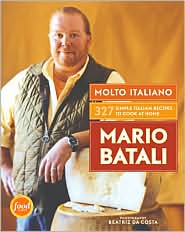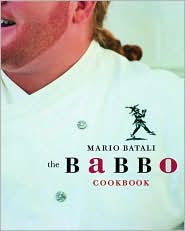“Antipasto
is Emilia-Ronagna has been based traditionally on the region’s outstanding
pork products, namely Prosciutto di Parma and other salumeria,
or
cured meats,
such as salami, culatello, and capicola. Parmigiano-Reggiano
also
is served in a
variety of straightforward but delicious preparations as a
way to
pique the
appetite at the beginning of a meal.
Historically,
the presence of an antipasto on a home menu was a sign of
prosperity,
as the
poor generally ate only pasta (an inexpensive way to fill
up), sometimes
followed by secondo based on meat or fish…
Restaurants
in Italy and America now offer vast assortments of antipasti,
and
offering three
or four of these dishes in succession or all at once can be
an
enjoyable and
more casual way of dining. Since may of these dishes can
be
prepared in advance
and served at room temperature or finished at the last
minute, the antipasto
course makes a lot of sense for the home entertainer.
Of
course a certain amount
of Italian food sense is essential to creating a
harmonious meal of even small
dishes.
One of the
main points that distinguishes cooking in Italy from cooking
in
America
is the
level of intensity that is maintained throughout a meal.
Italians
tend to expect
a series of plates of equal size, including at least
one,
if not
several, pasta
courses on the road to a full repast that includes
a
significant
secondo, or
entrée…
The most
important thing to remember when making and serving antipasti…
is
to enjoy the
process from the shopping through the cleanup. It is like a
dance,
joyful,
sometimes repetitive, yet always satisfying, nourishing the
body
as well
as
the
soul. Assessing the tastes and needs of your guests and
meeting
them with
style
is what great hospitality is all about, and it’s
ultimately what distinguishes
your
table
from mine.”
Grilled Linguica Crostini with
Red Onion
Marmalade
Serves 4
“Although
historically these garlic sausages are a product of Portugal,
I buy
linguica
from Faicco’s Italian pork store on the corner of Cornelia
and Bleecker, where
it is made fresh every day. The combination of sweet
marmalade and salty,
garlicky sausage is a natural for this quick-to-finish
appetizer. The marmalade
will hold up for two weeks, covered in the refri-
gerator, and is also good for
tortellini in chicken broth or on sandwiches.”
[Ed.
Note: Any fine-quality garlic
sausage may be substituted. Since I
reside in the Andouille Capitol of the World (LaPlace, LA) it will not be a
difficult choice for
me. I’ll
just run down to Jacob’s and see what’s cooking!]
2
medium red onions, cut into 1/4-inch dice
2 cups fresh orange juice
1 cup Port wine
1 cup water
1 teaspoon salt
1 tablespoon sugar
8 ounces linguica sausages [or other garlic sausages]
Twelve 1-inch-thick slices Italian peasant bread
Grated zest of 1 orange
Preheat
the grill or broiler.
In
a saucepan, combine the onions, orange juice, wine, water, salt,
and
sugar.
Bring to a boil; reduce this mixture to a thick marmalade
consistency, about
20
minutes. Set aside.
Place
the sausage on the grill or under the broiler and cook thoroughly,
5
to 7
minutes per side, turning frequently. Remove from the grill and
slice
into 1/2-inch-thick
rounds.
Grill
the bread until lightly toasted on both sides. Smear each slice with
about
2
tablespoons of the onion mixture, then arrange 4 or 5 slices of
sausage on top.
Garnish with the orange zest and serve.
Bruschetta
“The terms
‘bruschetta’ and ‘crostini’ are often used interchangeably in
America,
but there are differences in preparation. Derived from, ‘bruscare’,
the verb
meaning
to char over hot coals, bruschetta is a grilled bread that is
invariably
served warm, often with nothing more than a drizzle of good oil
and
the rub of a
raw garlic clove. (If you do not have hot coals ready to grill
your
bread, a
broiler works as well.) This
is also referred to as fett’unta, or
greased
slice, and is served in the time of new oil
to showcase the intense
flavor of
the
fall crop. Crostini, on the other hand, are
often fried or toasted
and can
be
served cool or at room temperature, usually
smeared with some
chicken liver
paste (for Crostine Toscane) or with a pâté of
livers. The varia-
tions are
endless for either, but I return again and again to
these bruschetta
toppings,
as
they are quick to make yet large on flavor:
White beans and rosemary
Sautéed summer squash with garlic and marjoram
Shrimp sautéed with garlic and lemon zest
Eggplant cooked al fungo
Sautéed turnips with Prosciutto and sage"
Bruschetta
with Bresaola, Eggplant,
and Mozzarella
Serves 4
“Served
with a salad and a couple of olives, this simple,
satisfying
dish
can easily
make a light lunch.”
3
tablespoons extra-virgin olive oil
1/2 medium red onion, thinly sliced
2 small Japanese eggplants
2 tablespoons red wine vinegar
8 ounces fresh mozzarella cheese
8 basil leaves, cut in narrow ribbons
(chiffonade)
Salt and pepper
4 slices Italian peasant bread
4 ounces Bresaola, sliced paper-thin
(12-15 slices)
Note: Prosciutto or capicola may be
substituted for the bresaola
In
a 10- to 12-inch sauté pan, heat the olive oil until smoking over medium heat.
Add the onion and cook until soft, 9 to 10 minutes. Meanwhile, cut
the eggplant
into 1/2-inch-thick rounds. When the onion is softened, add
the eggplant to the
pan and cook, stirring regularly, until the eggplant has darkened and is soft,
about 7 to 8 minutes. Add the vinegar and remove
from the heat
to cool.
Cut
the mozzarella into 1/4-inch cubes and add to the cooled eggplant
mixture. Add
the basil and season to taste with salt and pepper.
Preheat
the grill or broiler.
Grill
or toast the bread on both sides and spoon a generous amount of egg-plant over
each slice of bread. Top each with 3 slices of bresaola and serve.
Shrimp Bruschetta from “da Zaccaria”
Serves 4
“I could
wax poetic for days about the cooking of the Amalfi coast, and in
particular
about my love of one perfect seafood trattoria in Atrani called da
Zaccaria. Try
this recipe and you’ll see why. The success of this deceptively
simple
appetizer depends entirely on the quality of the shrimp. Limoncello is a
sweet
lemon-flavored liqueur made all over Amalfi, and it’s actually quite a
hangover producer. Though the alcohol cooks out, a deliciously pungent
fragrance
remains.”
1/4
cup extra-virgin olive oil
2 garlic cloves, thinly sliced
12 large shrimp, peeled and deveined
Juice and finely grated zest of 1 lemon
2 ounces Limoncello liqueur
1/2 cup dry white wine
Four 3/4-inch-thick slices Italian peasant bread
1 bunch chives, snipped into 1/4-inch lengths
Salt and pepper
Preheat
the grill or broiler.
In
a 12- to 14-inch sauté pan, heat the olive oil over medium heat until
just
smoking. Add the garlic and cook until it turns light brown. Add the
shrimp and
cook without turning for 2 to 3 minutes, until bright red. Turn
the shrimp over
and cook for 1 minute. Transfer the shrimp to a plate
and
add to the pan the
lemon juice, Limoncello, and wine. Boil the sauce
for
3 minutes.
Grill
or toast the bread and place 1 slice on each plate. With tongs, transfer
3 of
the shrimp to each piece of bread. Stir the chives into the sauce in the
pan and
season with salt and pepper. Spoon the sauce over the shrimp,
sprinkle with the
lemon zest, and serve immediately.
Warm Terrine of Sausage, Peppers, Polenta,
and
Mozzarella
Serves 6
“After I
demonstrated this recipe on television, it became on of my most
requested ever.
It is definitely best made a day ahead and lends itself to
myriad variations.
At Pó, we often use soft goat cheese in place of the
mozzarella and also add
pitted Gaeta olives and chopped fresh thyme
leaves to different layers.”
8
ounces sweet sausage
2 tablespoons extra-virgin olive oil
12 garlic cloves, peeled and left whole
1 large red bell pepper, cored, seeded, and
cut into 12-inch-wide strips
1 large green bell pepper, cored, seeded, and
cut into 12-inch-wide strips
8 ounces fresh mozzarella cheese, cut into strips
3 inches by 1/4 inch
6 cups water
1 teaspoon salt
1 teaspoon sugar
2 cups quick-cooking polenta or yellow corn meal
1/4 cup grated Parmigiano-Reggiano cheese
Preheat
the oven to 350 degrees [F].
Arrange
the sausage in a baking pan and cook in the oven for 20 minutes. Drain off the
fat, then crumble the cooked sausage to resemble rough
bread crumbs. Set aside.
In
a medium sauté pan, heat the olive oil over medium-low heat. Gently
sauté the
garlic until golden brown on all sides, 8 to 10 minutes. Add the
bell peppers
and sauté until soft but not browned, 7 to 8 minutes longer. Remove from heat,
transfer the garlic and peppers to a bowl, and let cool.
Bring
the mozzarella to room temperature. Arrange the sausage, peppers,
garlic and
mozzarella in separate bowls. Set out a terrine, 13x4x4 inches.
Bring
the water to a boil, adding the salt and sugar. Slowly add the polenta
to the
boiling water in a thin stream, whisking continuously. Lower the
heat and cook
until the polenta resembles the texture of hot cereal, 2 to 3
minutes. Remove
the pot from heat. The polenta will begin to thicken immediately, so time here
is of the essence.
Moving
quickly, pour a 3/4-inch layer of polenta into the prepared terrine. Sprinkle all
the crumbled sausage over the polenta. Cover the sausage with about 1 1/2 cups
more polenta, using a spatula to smooth the top. Next,
make a layer with the
peppers and garlic cloves and top with another
1 1/2 cups warm polenta. Smooth and
flatten the polenta to make a nice,
even
layer all the way to the edges. Arrange
the mozzarella over polenta
(but
do not bring the mozzarella to the edges as
it will stick to the sides
when it melts). Fill the terrine with a final layer
of warm polenta; there
may be
polenta left over. Smooth the top all the way to
the edges.
Cover the
terrine with plastic wrap and chill overnight.
Preheat
the oven to 475 degrees F.
To
serve, invert the terrine onto a cutting board. (It should come out quite
easily.) Cut the terrine in 3/4-inch-thick slices. Place the slices on a baking
sheet and bake for 10 to 12 minutes. Sprinkle with the grated cheese and
serve
immediately.
More from Chef Mario Batali:
At-Home Comfort Food
Babbo's Bollito Misto
Balsamic Glazed Chicken with
Grilled Radicchio
Cool Chicken Braciole Messinese
T-Bone Steak Fiorentina with
Sautéed Spinach and DaVero Olive Oil
Featured Archive Recipes:
Bruschetta with Scallops Provençale
Bruschetta with White Beans, Tomatoes
and Olives
Crostini con Peperoni
Grilled Shrimp with White Beans,
Rosemary, Mâche, and Mint Oil
More Lagniappe Recipes!
Index - Appetizer Recipe Archives
Party Central!
Daily Recipe Index
Recipe Archives Index
Recipe Search











